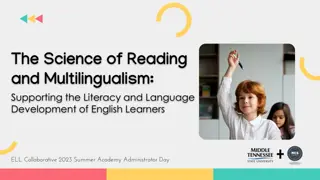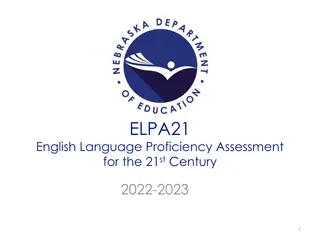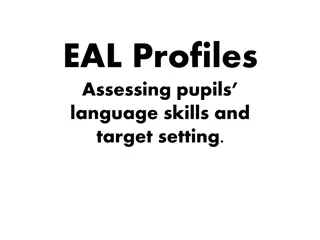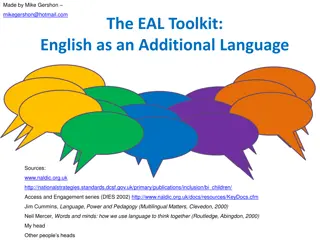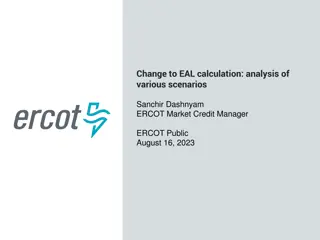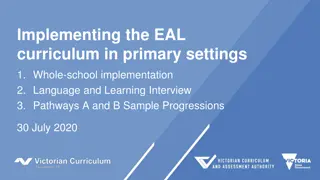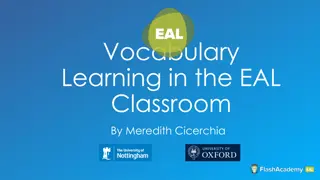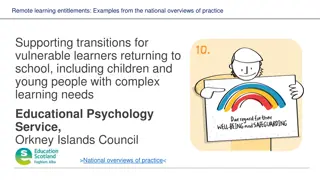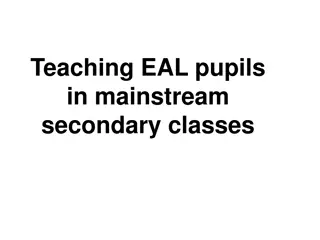Supporting Strategies for English as an Additional Language (EAL) Learners
Strategies and examples are provided to support new EAL students in the classroom, including creating an inclusive environment, utilizing non-verbal aids, pre-teaching vocabulary, offering additional literacy support, and promoting vocabulary building through games. The importance of essential vocabulary, key word introduction, and language learning through games are highlighted to enhance the learning experience for EAL learners.
Download Presentation

Please find below an Image/Link to download the presentation.
The content on the website is provided AS IS for your information and personal use only. It may not be sold, licensed, or shared on other websites without obtaining consent from the author.If you encounter any issues during the download, it is possible that the publisher has removed the file from their server.
You are allowed to download the files provided on this website for personal or commercial use, subject to the condition that they are used lawfully. All files are the property of their respective owners.
The content on the website is provided AS IS for your information and personal use only. It may not be sold, licensed, or shared on other websites without obtaining consent from the author.
E N D
Presentation Transcript
TRAINING All Staff could be trained in the following areas: EAL PEDAGOGY LESSON PLANNING ASSESSMENT
Strategies Supporting New EAL Students in the Classroom Don t panic! Provide an inclusive environment so the pupil feels happy and safe. Put pupils in groups/sets appropriate to their ability in home language, nottheir current English language skills. Pair up with a buddy or a group of buddies good language role models. Allow group work to help pupils learn both English and context. Use non-verbal supportaids such as flash cards to indicate pupil s needs toilet, feeling unwell etc. Try to make instructions for activities precise pictures and diagrams help. Encourage any attempts by EAL pupils to communicate. Allow extra time for EAL pupils to understand and respond to spoken English. Pre-teach curriculum vocabulary (given before the lesson) for new class topics, which the pupil can view at home. Vocabulary lists/copies of texts for pre/post lesson study Use modelling, diagrams, pictures/words/sequencing to link concepts and new vocabulary. Use sentence starters and writing frames for written work - it is ok if they want to write in their home language at first. If possible, order a bilingual dictionary for use in the classroom. Don t worry if there is a silent period this is normal. Make time for weekly catch ups with class teacher to promote their learning and provide more support. Additional Literacy Support - Language programmes e.g. Talking Partners, Ealip and other booster programmes. Let them settle into school for a few weeks before contacting the EAL service with a referral. Have Fun EAL TEAM: Lorraine Brown, Becci Morris, Quynh Chu Thu - 0151 443 5136
EXAMPLES OF GOOD PRACTISE FOR EAL LEARNERS Provide students and if necessary, parents with essential vocabulary. Building vocabulary EAL learners of all ages and at all stages of English language proficiency need additional support to increase their vocabulary in different curriculum contexts. Introduce key words and phrases before starting a new topic, if possible, translate them into learner s own language. Learning language through games is very useful especially when repeated phrases are used. Example I went to the market and I bought .., each player needs to remember all the previous items and add one of their own.
Snap using flashcards with words and pictures on them. Bingo again using flashcards. Learners work in teams in order to win they have to make sentences that include all the words. Matching games - again using flashcards. Have a word or phrase of the week for all learners.
Collect all newcomer information all information collected will help Staff have insight to the learner and help in planning tasks and work for the student. Ensure there is always a friendly member of Staff to welcome the student and their parent/carer. At the interview ensure the following is in place a welcome pack, information about the school and the processes involved e.g. what to do if the student is unwell, the importance of attendance. Uniform and equipment needed, times of the school day, holidays. If possible, this to be translated into letters in the language of the new student. Give a tour of the school this can be led by the new buddy of the student.
TRAINING This can take the form of whole school training, individual based training, support staff training. EAL pedagogy is discussed Content integrated learning Lesson planning The aim of the training is to promote inclusiveness for the EAL learner
General advice What to expect Do not worry, in the early stages, if the pupil appears not to be making the same rate of progress as others. Most pupils learning through EAL will have developed L1 to an age appropriate level, but when matched against communication in English it may appear that their language reflects that of a younger person. For monolingual English speakers, this might be an indicator of additional needs. In the case of a pupil learning an additional language, a snapshot of what s/he can do from [an EAL] assessment will show a more accurate picture. Do not worry if the pupil is not keeping with the rest of the class. It is more important that s/he learns something than that s/he completes something. Make sure anyone supporting in the classroom understands that the pupil s tasks can be reduced in order to spend more time consolidating new language or explaining content. Vocabulary development remains a priority for bilingual learners in both early and later stages, even when they are high achievers. Practitioners will need to focus on building vocabulary and revisit often. Expect fast progress. Many English-speaking pupils benefit from provision made for EAL. An EAL-friendly lesson is an inclusive lesson. Import EAL strategies into everyday practice rather than worrying about creating a special lesson just for one or two pupils. Bilingual pupils will need to be given intellectually challenging work (unless they have been identified as having learning difficulties). Have high expectations and watch out for both fastprogress and suddenplateaux. Both are features of learning through an additional language. Watch out for small cultural misunderstandings which can cause bigger comprehension gaps or confusion about tasks. Avoid making assumptions, and ask questions to check comprehension.
Strategies to try All the ideas below would be found in quality first lesson design by language aware practitioners. The form this provision takes will vary according to age group, subject content and the developing needs of different learners in the class, but the elements of the provision will not change. Encourage and facilitate use of other languages as learning tools. Provide opportunities for the learner to link to prior knowledge. Provide contextual support for meaning. As part of the lesson design, provide explicit models of language, with opportunities for learners to practise, produce and reflect on their use Provide scaffolding for language production as part of the lesson design. Use Tell me about this and Show me as prompts or conversation starters. Give thinking time, learners may be translating in their heads. Provide age-appropriate ICT. Most practitioners find flexible seating or grouping useful. Bilingual learners benefit from good models of language use and learning behaviour. Peer support adds to differentiation options.
ASSESSMENTS These can be carried out in school or remotely. A referral form must be filled in before an assessment can take place. NASSEA framework is used, this also gives National Curriculum levels



